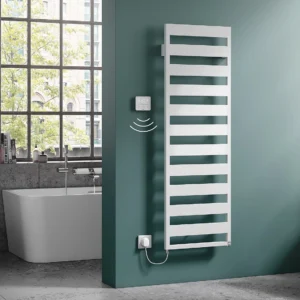What Are Electric Radiators?
A Quick Overview
Electric radiators are exactly what they sound like—radiators that run on electricity. No gas lines, no central heating systems, just a plug and a plan to stay warm. They’re gaining popularity for good reason.
How They Work
Think of them as a toaster, but safer and way more stylish. They convert electric energy into heat using elements like ceramic, oil, or dry technology.The warmth is at that point equitably dispersed through your room, making beyond any doubt each corner is cozy.
Why Select Electric Radiators Over Conventional Warming?
Efficiency Wins
Traditional systems lose heat in pipes or struggle with consistent temperatures. Electric radiators? They give heat straight to your space, with barely any waste. That’s what we call efficiency.
Installation Simplicity
No drilling gas lines. No need to rip up your floors. Just mount it on the wall (or don’t—some are freestanding), plug it in, and voilà—instant warmth.
Cost-Effectiveness
Initial costs are low, and with smart controls, you can micromanage when and where your radiators run. That means no more paying to heat an empty room.
Types of Electric Radiators
Oil-Filled Radiators
These are the classic models. They use oil sealed within the unit to retain and radiate heat, even after you switch them off. Great for steady, consistent warmth.
Dry Thermal Radiators
Fast-acting and light, these use metal elements to heat up. If you need warmth now, this is your go-to.
Ceramic Core Radiators
Ceramic retains heat like a champ.These units are inconceivably productive and perfect for well-insulated homes.
How to Select the Proper Electric Radiator for Your Space
Consider Room Size
Bigger rooms need more power, simple as that. Check the wattage—usually around 100 watts per square meter is a solid starting point.
Think About Your Usage
Primary vs. Secondary Heating
Is this your main heating source, or just a backup for cold snaps? That answer will help decide the size, type, and features you’ll want.
Design and Aesthetics Matter
You don’t want a clunky metal box ruining your décor. Luckily, electric radiators come in slimline, vertical, and even mirrored styles now. Yes, your heater can double as wall art.
Benefits of Electric Radiators
Vitality Productivity and Supportability
Electric radiators change over about 100% of power into warm. That’s as effective because it gets, particularly on the off chance that you’re pulling that power from renewable sources.
Total Control at Your Fingertips
Savvy indoor regulators, clocks, and app controls let you customize your consolation zone, room by room. You’re in charge.
Minimal Maintenance
No moving parts, no boilers, no bleeding required. Just occasional dusting and you’re golden.
Electric Radiators vs. Gas Heating
Running Costs Breakdown
Electricity might cost more per unit, but gas systems lose efficiency over time. Plus, with zone heating, you only heat what you use.
Safety Comparison
Electric systems don’t emit carbon monoxide and don’t require gas checks. They’re about as safe as a smartphone charger.
Smart Electric Radiators: The Future is Here
Wi-Fi and App Integration
You can now control your radiator from your phone—even when you’re not home. Heading back early from work? Preheat your living room from the bus.
Smart Scheduling and Zoning
Create custom schedules for each room.Like a warm pixie adoptive parent, your radiator turns on fair after you require it.

Are Electric Radiators Eco-Friendly?
Decreased Carbon Impression
They emit zero emissions on-site. Pair them with green electricity and you’re heating your home guilt-free.
Pairing with Renewable Energy
Got solar panels? Perfect match. Electric radiators thrive on clean energy, making them a cornerstone of sustainable living.
Installation Tips and Tricks
DIY or Hire a Pro?
If you’re handy, go for it—many models are plug-and-play. Wall-mounted models may require a drill and level, though. For hardwiring, call in an electrician.
Common Mistakes to Avoid
Do not block them with furniture.
Don’t undersize for the room.
Don’t ignore the user manual (yes, seriously).
Maintenance and Longevity
Cleaning and Care
Just a wipe with a dry cloth now and then. Avoid water—this isn’t your showerhead.
Lifespan and Warranty
Expect 10-15 years of reliable heat. Many come with warranties of 5 years or more. That’s heating peace of mind.
Common Myths About Electric Radiators
They’re Expensive to Run
Not if you use them smartly. Zoning, timers, and insulation make a huge difference. Plus, no boiler maintenance fees!
They Don’t Heat Well
Ever hugged a ceramic radiator? They heat fast and hold that warmth.One might contend they’re indeed as well great at it.
Conclusion
Electric radiators are more than fair a present day convenience they’re a jump forward in domestic warming. With smooth plans, savvy tech, and a center on vitality productivity, they tick all the boxes for consolation, taken a toll, and supportability. Whether youâre updating your whole framework or fair searching for a warming boost in one room, electric radiators are worth genuine thought.Stay warm, stay smart, and maybe… stay off the gas grid entirely?
FAQs
Q1: Are electric radiators cheaper to run than gas central warming?
A: It depends on your utilization and vitality supplier, but when utilized efficiently especially with zoning and timers electric radiators can be exceptionally cost-effective.
Q2: Do electric radiators require adjusting like gas boilers?
A: Nope! That’s one of their biggest perks. Just keep them clean and dust-free.
Q3: Can I utilize electric radiators in lavatories?
A: Yes, but make beyond any doubt to select one with an suitable IP rating for dampness resistance and take after security rules.
Q4: Are they secure to take off on overnight?
A: Completely. Most models have security highlights like overheat security and programmable shut-offs.
Q5: Can I install them myself?
A: Many are DIY-friendly if they’re plug-in. Wall-mounted or hardwired ones might need a professional touch, especially for secure fitting.

